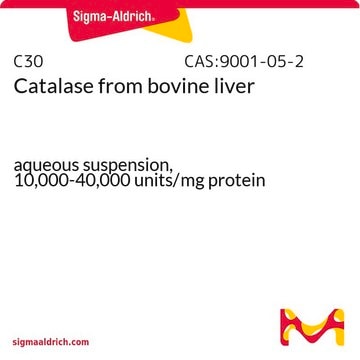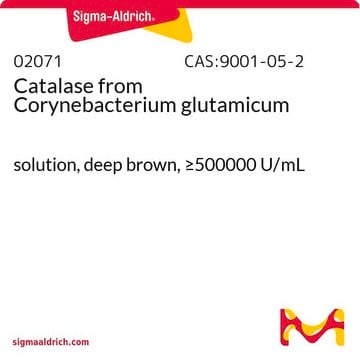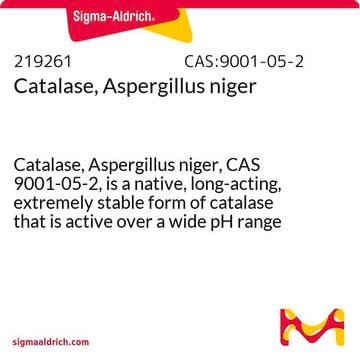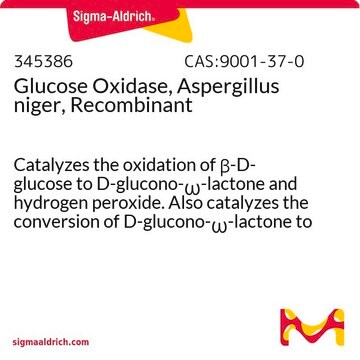C3155
Catalase from bovine liver
aqueous solution, ≥30,000 units/mg protein
Sinónimos:
H2O2:H2O2 oxidoreductase
About This Item
Productos recomendados
biological source
bovine liver
Quality Level
description
optimum pH ~ 7.0
sterility
aseptically filled
form
aqueous solution
specific activity
≥30,000 units/mg protein
mol wt
tetramer ~250 kDa
contains
≤0.10 mg/mL Thymol
composition
ammonium sulphate, 30-50%
catalase, 10-20%
storage condition
(Tightly closed. Keep locked up or in an area accessible only to qualified or authorized
persons)
technique(s)
activity assay: suitable
isoelectric point
5.4
pI
5.4
UniProt accession no.
shipped in
wet ice
storage temp.
2-8°C
InChI
1S/C9H10O3/c1-2-12-9(11)7-3-5-8(10)6-4-7/h3-6,10H,2H2,1H3
InChI key
NUVBSKCKDOMJSU-UHFFFAOYSA-N
Gene Information
cow ... CAT(280743)
¿Está buscando productos similares? Visita Guía de comparación de productos
General description
Catalase from bovine liver is a tetramer consisting of 4 equal subunits each with a 60 kDa molecular weight. Each of these subunits contains iron bound to a protoheme IX group. The enzyme will also strongly bind to NADP, where NADP and the heme group are within 13.7 angstroms.
Catalase from bovine is a tetrameric enzyme, consisting of four identical sub-units containing a single heme moiety per subunit. Each subunit has four domains like the α-helical domain, an eight-stranded β-barrel, N-terminal threading arm that is connected to the β-barrel via a wrapping loop.
Application
- as a component of the GLOX buffer during single molecule fluorescent in situ hybridization (smFISH) on primary mouse cortical neurons
- for its structural and kinetic analysis of its interaction with nitric oxide
- in the preparation of glucose oxidase-catalase system (GOX-CAT system) to generate H2O2 and study the effect of H2O2-induced oxidative stress on myelination in mouse organotypic cerebellar slice cultures
Catalase from bovine liver may be used:
- to prepare H2O2-O2 based biocathode for applications in glucose biofuel cells
- to study the kinetic properties and storage stability of catalase immobilized on to florisil
- in glutathione-mediated superoxide generation in an aqueous solution
Biochem/physiol Actions
Caution
Unit Definition
Preparation Note
inhibitor
signalword
Danger
hcodes
pcodes
Hazard Classifications
Resp. Sens. 1
Storage Class
12 - Non Combustible Liquids
wgk_germany
WGK 1
flash_point_f
Not applicable
flash_point_c
Not applicable
ppe
Eyeshields, Gloves, multi-purpose combination respirator cartridge (US)
Certificados de análisis (COA)
Busque Certificados de análisis (COA) introduciendo el número de lote del producto. Los números de lote se encuentran en la etiqueta del producto después de las palabras «Lot» o «Batch»
¿Ya tiene este producto?
Encuentre la documentación para los productos que ha comprado recientemente en la Biblioteca de documentos.
Los clientes también vieron
Protocolos
This procedure may be used for all Catalase products.
Nuestro equipo de científicos tiene experiencia en todas las áreas de investigación: Ciencias de la vida, Ciencia de los materiales, Síntesis química, Cromatografía, Analítica y muchas otras.
Póngase en contacto con el Servicio técnico













